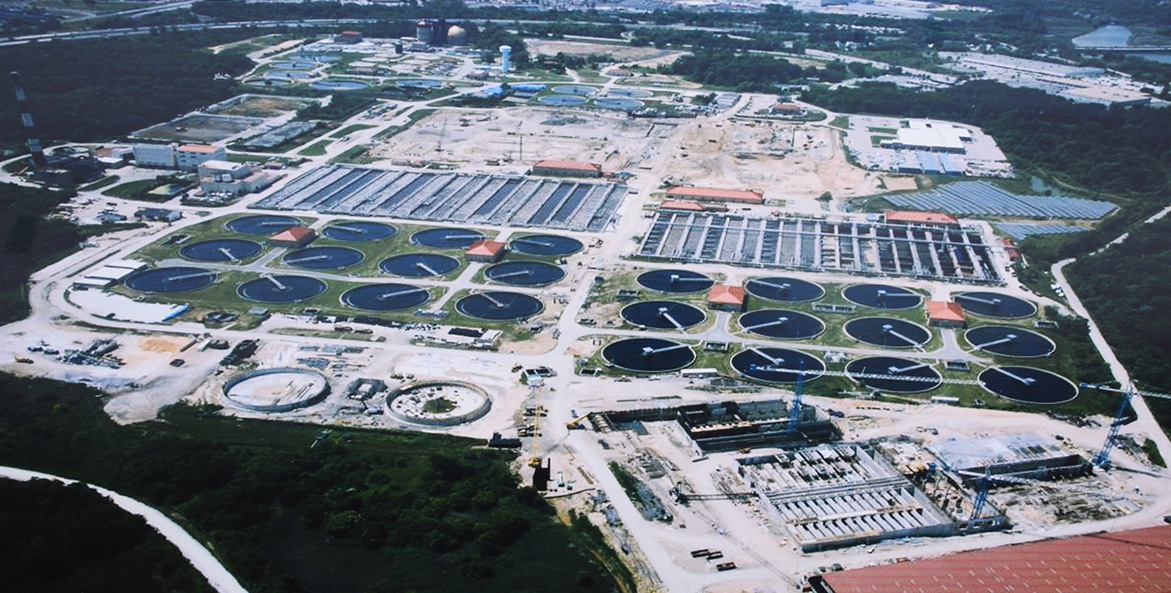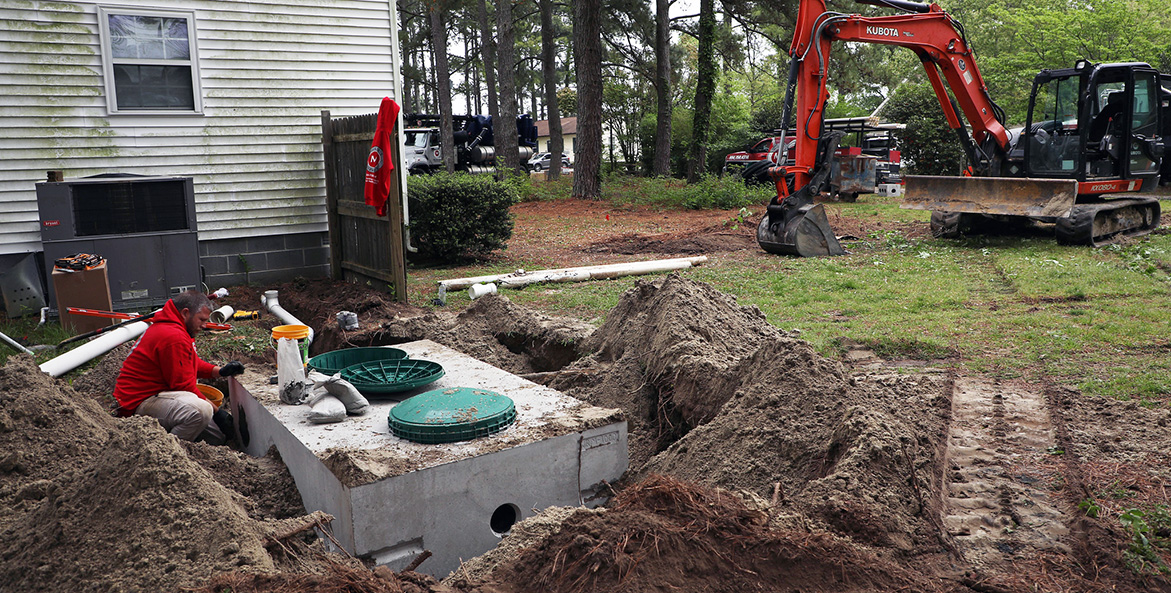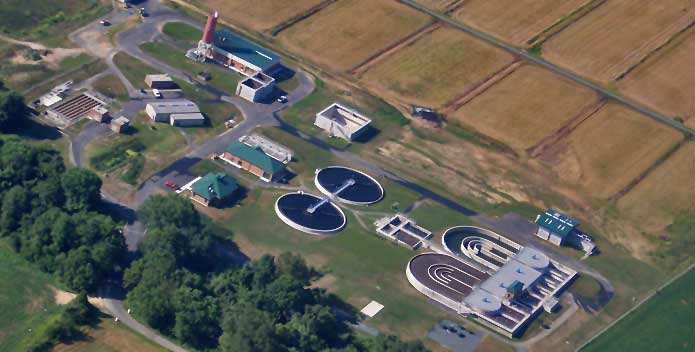Contents
What Is Wastewater? How Do Wastewater Treatment Plants Work? How Do Septic Systems Work Ongoing Challenges to Wastewater System Progress What CBF Is Doing What You Can DoWhat Is Wastewater?
Wastewater is any water that has already been used, such as water from household toilets, sinks, or laundry, from personal or community pools, and from industrial, commercial, or agricultural sources. It also includes surface runoff and water running through sewers.
Traditional wastewater treatment plants (also called sewage treatment plants) and septic systems were designed primarily to reduce bacteria, but not the nitrogen and phosphorus found in waste. Nitrogen and phosphorus in wastewater come from human and animal waste, food, and fertilizer in lawn and agricultural runoff.
Excess nitrogen and phosphorus degrade water quality. They feed algal blooms that block sunlight to underwater grasses and suck up life supporting oxygen when they die and decompose. Toxic algae not only kills fish, it also sickens animals and people.
How Do Wastewater Treatment Plants Work?
Basic sewage treatment from a wastewater plant typically involves the use of bacteria to break down organic matter and chlorine or other technologies to kill harmful bacteria and reduce odor. Chlorine is then removed before the treated water is released back into surface waters. This treated wastewater is typically discharged into streams, the Bay, or other waters or is reused for irrigation or fire suppression from a subset of plants known as water reclamation facilities. The treatment process also generates biosolids that can be applied on land as a soil amendment in agriculture where the nutrients are accounted for in a nutrient management plan for each farm.
To return more usable, safe water to receiving waterways, advanced waste treatment techniques are used to remove more difficult pollutants, such as heavy metals, chemical compounds, toxic substances, and nutrients like nitrogen and phosphorus. These techniques range from biological technologies capable of removing nitrogen and phosphorus to physical techniques such as a filtration, adsorption, distillation, and reverse osmosis.
The good news is that upgrades and operational efficiencies at sewage plants throughout the Chesapeake Bay watershed have resulted in steep reductions in nutrient pollution. These improvements have been paid for through billions of dollars of public funding, but the benefits from cleaner water far exceed the costs.
Since the regional Bay clean-up plan—called the Chesapeake Clean Water Blueprint—was established in 2010, the wastewater sector cut nitrogen levels from 52 million pounds to 26 million pounds annually, as of 2021. That’s real progress. This reduction already exceeds the 2025 Bay Blueprint target, according to a Chesapeake Bay Program analysis.
However, in Maryland, ongoing maintenance and operational issues at two wastewater treatment plants has recently caused an increase in nitrogen pollution. In July 2022, the Maryland General Assembly passed a law requiring the Maryland Department of the Environment to increase inspections and enforcement activities. CBF hopes the new law will prevent these types of failures in the future.

While upgrades at sewage treatment plants across the Bay watershed have resulted in steep reductions in nutrient pollution, maintenance and operational issues can still sidetrack progress. Pictured: Baltimore's Back River Wastewater Treatment Plant.
Joe Andrucyk/Back River Wastewater Treatment Plant
How Do Septic Systems Work?
The significant progress made in reducing pollution from sewage plants has not been matched in more suburban and rural areas where onsite septic systems are used to treat human waste. These backyard systems are responsible for a large portion of household waste in many counties in the Bay region. Efforts to reduce nitrogen pollution from septic systems are lagging, with these systems releasing about 7.8 million pounds a year, an increase of more than 200,000 pounds since 2010.
Within septic systems, wastewater that passes beyond the holding tank is treated by the slow release of water into the soil. Solids containing most of the phosphorus build up in the tank and must be pumped periodically. When functioning properly, these systems reduce the loads of nitrogen and phosphorus to levels the Bay can safely absorb.
Newer “best available technology” or BAT systems use oxygen and other treatments to reduce the amount of nitrogen and pathogens in waste before it is released into the surrounding soil. Since the homeowner is responsible for the expense of replacement, replacing old septic systems with more advanced ones is a costly and slow process.

Backyard septic systems are responsible for a large portion of household waste in many counties in the Bay region. Efforts to reduce nitrogen pollution from septic systems are lagging.
Virginia Sea Grant
Ongoing Challenges to Wastewater Treatment Progress
Problems loom, however. As more people move into the Bay area, flows to sewage treatment plants will continue to increase. Also, climate change is bringing more and heavier storm events, flooding, sea level rise, and temperature changes. Moving forward, jurisdictions will need to ensure that this sector maintains its nutrient pollutant limits in the face of these factors.
Conventional septic systems also were not designed to work under the conditions of sea level rise, erosion, land subsidence, or increasingly waterlogged soil caused by flooding and stronger storms. Sea level rise and land subsidence inundate septic systems with water causing them to fail. Failing septic systems—whether for this or other reasons—-result in leaks that send sewage into groundwater and surface water, ultimately polluting local rivers and the Bay and creating human health risks. As a result, coastal communities that depend on septic systems face significant challenges.
In many cases, areas with a high number of septic systems coincide with low-income and historically disenfranchised communities. These are areas with no access to centralized public sewer systems. Frequently, they also have poor soils that don’t even support conventional septic systems well.
What CBF is Doing
The watershed states are on pace to meet their 2025 Blueprint targets for wastewater ahead of schedule, largely by installing better technology at treatment plants, enhancing the efficiency of existing treatment plant technologies, or purchasing credits that reduce treatment plants’ contribution to nutrient pollution.
CBF continues to monitor treatment facility performance and advocate for practices that will enable states to retain the accomplishments they have already made, including:
- Dedicated funding and enhanced technical assistance to treatment plants, to help plants develop and implement plans to optimize nutrient reduction with existing technologies.
- Sufficient regulatory and inspection staffing to ensure performance is maintained through onsite inspections, permit application and renewal reviews, and monthly discharge reporting.
On the septic system side, new septic systems are required to use a state-approved treatment technology. But many systems are old and not to today’s standards.
CBF advocates for important actions needed to improve the state of septic systems across the watershed, including:
- Funding to support septic upgrades for homeowners.
- Strong tracking and enforcement of existing inspection and pumping requirements.
- Continued investment in connecting homes to sewer service, especially in critical areas and those experiencing heavy rainfall and flooding.
- Targeted use of advanced denitrifying technology, which can be an optimal solution for some locations.
In Pennsylvania, CBF continues to recommend that the state establish a county-based offset program to address nitrogen loads from new or substantially rehabilitated septic systems. The program would determine the average total nitrogen load over the course of the expected lifespan of the system and a one-time fee applied to building permits. This fee would be used by local entities, such as county conservation districts, to fund nonpoint source pollution reduction practices within the county.
Maryland adopted incentives for counties that develop plans to address failing septic systems and those in the path of sea level rise. CBF encourages thoughtful management and retirement of these systems to improve water quality while preventing over-development. CBF remains concerned about ongoing issues at Baltimore's Back River and Patapsco plants. See our page on Baltimore's Wastewater Treatment Plants for more information.
Virginia is currently considering amending its septic regulations to account for the challenges of sea level rise and climate change. CBF has participated in this regulatory development process to ensure the regulations discourage the development of new septic systems in flood-prone areas and provide options to address septic systems that are failing due to impacts of climate change. CBF also supported legislation in Virginia that provides grants and loans for repairing or replacing failing septic systems for property owners whose income is below a percentage of federal poverty guidelines.
What You Can Do
- Reduce excess nitrogen and phosphorus that needs to be treated by reducing your use of lawn fertilizer.
- Follow safe and legal disposal practices for common household products, including but not limited to paint and stains, paint solvents, motor oil, pesticides, pool chemicals.
- Look for safer alternatives to hazardous cleaners.
- Look for chemical-free alternatives to personal products like cosmetics and hair dye to prevent chemicals from washing down your drain.
- If you have a septic system follow recommended maintenance, such as annual inspections and getting it pumped every three to five years. Conserve water to reduce the strain on your septic system and prevent the possibility of backups.



